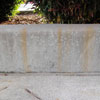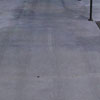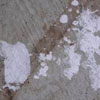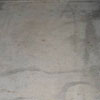Acid Pressure Washing Damage
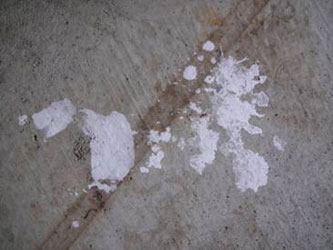
Pressure washers will apply acid because it leaves a much whiter appearance and then requires much less time and effort to clean the surface, thus saving a pressure washer time and money. The drawbacks are that it etches the surface and weakens the concrete so it absorbs more stains.
Common acids that are used for this purpose are, Hydrofluoric and Hydroxyacetic acid. Both of these acids have a whitening effect on concrete and stains, but both do so by attacking the lime that holds the concrete together. Normally something less than one percent solution is used, however to do this damage the dilution was probably around 7%.
The best way to preserve what is left of the concrete after acid damage is to clean the concrete with an alkaline soap which will help neutralize the residual acid and then apply a sealer to reduce natural water damage and erosion.
Acid Damage Example 1

In this particular case the employee used an excessive amount of hydrofluoric acid, probably above 7%. Normally when acids are applied they are applied at something less than 1% solution. All acid application has this damaging effect and is accumulative. This example stands out so starkly because of the excessively strong application that was used.
The striping effect you see is where the surface cleaner edges passed over the concrete allowing the nozzles more dwell time which then remove more of the concrete from the surface. Acid etching not only damages the concrete in terms of removal but also softens the remaining concrete which makes it more susceptible to staining.
There is no repair for this kind of damage but an alkaline washing may neutralize the remaining acid which dries to a powder and reactivates each time it becomes wet. It would be best to follow-up with a very good sealer trying to strengthen the remaining surface and protect it from additional water erosion damage.
Note the difference between the chalky looking surface under the overhang of the building as compared to that concrete which is subject to direct rainfall.
Acid Damage Examples 2 & 3
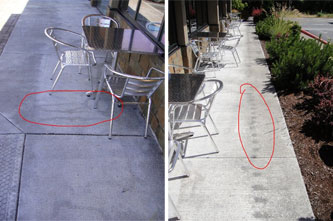
These two pictures are examples of acid damage as well. On the left you can see where a flower pot once set; the acid pooled behind and around it streaming toward the curb. As the area was then cleaned with a pressure washer the cleaning removed the surface of the soften concrete.
In the picture on the right you can see where the concrete had been softened by acid and then the rain water dripping from the corrugated roof above made this dotted pattern as it removes the softened concrete.
Pressure washers will use acid in the process of their cleaning to benefit themselves. The benefit to the pressure washer is that takes less time and pressure to clean, due to the acid reacting to the lime in the concrete the dirt is released as the surface of the concrete is released . This softened concrete is much easier to clean and remove than is dirt and gum which is adhering to concrete that has not been softened in this way. A side benefit is the bleaching effect of the acid which leaves a much whiter looking concrete.
Unfortunate for the consumer this whitening effect caused by the acid often helps the pressure washer sell his service because of the dramatic whitening. I say unfortunate because what happens is as each application of acid is apply the acid is removing some concrete eventually exposing the sand and then the rocks in the concrete ultimately darkens the surface making it more porous and more susceptible to stains and dirt accumulation.
In most cases when the acid is applied at a low percentage rate this deterioration would not show for many cleanings but is always heading in this direction. Many times the owner of the property would think this was normal deterioration when in fact it is accelerated deterioration.
The damage here is so suddenly visible only because the employee used too much acid in one cleaning. But after an accumulation of cleanings even with less than 1% solution, concrete will eventually look like this.


